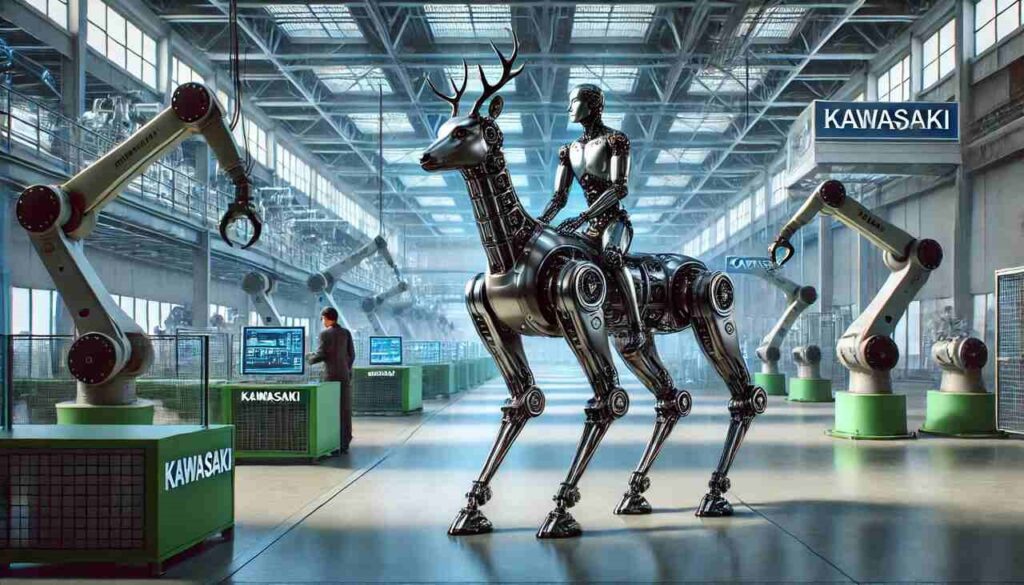What Is Kawasaki’s Bex and How Does It Redefine Rideable Robotics?
Kawasaki’s new concept robot, named Bex, is a rideable quadruped robot modeled after a wild goat species called the ibex. Unveiled at the 2025 International Robot Exhibition, Bex embodies biomimetic engineering, designed to transport both humans and cargo in rugged industrial environments. Capable of transitioning between walking and wheeled locomotion, Bex serves as a prototype for future autonomous logistics platforms and human-robot mobility systems.
Engineered under Kawasaki’s Kaleido robotics program, Bex blends humanoid motion control with multi-modal navigation systems, providing both manual ride-on operation and remote autonomous control for variable terrain use.
How Does Bex Leverage Biomimicry in Its Design and Locomotion?
Ibex-Inspired Quadrupedal Form
The robot mimics the anatomy of the Capra ibex, a mountain goat known for navigating steep, uneven terrains. This biological reference enables the robot to balance, crouch, and adapt its posture across sloped or rocky surfaces, making it suitable for agriculture, forestry, and disaster relief operations.
Articulated Limb Movement
Each of Bex’s legs features multi-jointed actuation to emulate natural gait patterns. These limbs are supported by inertial measurement units (IMUs) and force sensors that ensure adaptive contact pressure and leg stabilization during walking sequences.
Dynamic Posture Adjustment
The robotic body can raise or lower its center of gravity, optimizing for different use cases—riding, crouching under objects, or maintaining balance during cargo loading. This adjustable posture also facilitates human interaction and safety compliance.
Nature-Inspired Stability Algorithms
The locomotion software incorporates algorithms modeled on animal neuromuscular systems, giving Bex the ability to recover from instability using reflex-like motion pathways—a key advantage for unstructured environments.
What Dual Locomotion Capabilities Make Bex Unique in the Robotics Market?
Quadrupedal Walking for Uneven Terrain
Bex can walk using its four legs when navigating gravel, slopes, or construction zones. Its real-time terrain assessment allows for micro-adjustments in foot placement, ensuring secure ground contact even on variable surfaces.
Wheeled Mode for Speed and Efficiency
On flat surfaces, Bex retracts its legs partially and switches to wheeled drive mode, allowing for smoother, faster movement. This hybrid mobility provides both terrain adaptability and transport efficiency, making it versatile across operational contexts.
Seamless Transition Mechanism
Integrated actuators and sensor fusion allow the robot to switch between legged and wheeled locomotion without stopping, minimizing downtime and enhancing productivity for field operations or logistics use.
Load-Adaptive Gait Calibration
Bex dynamically adjusts its gait and wheel torque based on passenger or cargo weight, ensuring energy efficiency and structural stability. This makes it ideal for transporting payloads across large warehouse floors or remote field stations.
What Are the Industrial and Commercial Applications of the Bex Robot?
Last-Mile Delivery in Harsh Environments
Bex can carry tools, equipment, or goods over rough or inaccessible terrain where conventional delivery vehicles cannot operate, such as mines, construction sites, or remote farms.
Workforce Augmentation in Industrial Zones
The rideable feature offers utility in factories and logistics hubs, enabling personnel to traverse large facilities more efficiently, especially in hazardous or expansive production zones.
Search-and-Rescue Deployment
With its biomimetic gait and posture control, Bex can navigate collapsed structures, forest trails, or mountain paths, aiding rescue teams by transporting medical kits or extracting injured individuals.
Autonomous Field Surveillance and Monitoring
Equipped with camera systems and IoT connectivity, Bex can patrol industrial areas, check infrastructure integrity, or monitor environmental changes in forestry, agriculture, or energy facilities.
What Are the Technological Foundations Behind Bex’s Intelligent Mobility?
Advanced Control via Kawasaki Kaleido System
The Bex platform inherits core technologies from Kawasaki’s humanoid Kaleido robot, including balance control algorithms, motion planning AI, and real-time sensory feedback systems.
Sensor Fusion for Terrain Recognition
Bex uses lidar, stereo vision, and gyroscopic sensors to map its surroundings and determine optimal routes, whether walking or rolling. The sensors allow it to react to obstacles or ground shifts autonomously.
Edge AI Processing and Onboard Computation
With an onboard NVIDIA Jetson platform or equivalent AI module, Bex processes data in real time, executing gait adjustments and route decisions without needing constant cloud connectivity.
Modular Architecture for Custom Payloads
The robot includes a swappable cargo bay or modular seat configuration, allowing it to adapt to multiple industrial use cases, from ride-on personnel transport to automated tool carriers.
Conclusion
Bex exemplifies the future of multi-modal robotic platforms, merging biomimicry, rideable design, and AI-guided adaptability. By addressing the operational gaps between bipedal humanoids and autonomous wheeled bots, Kawasaki introduces a new robotics category ideal for real-world industrial use, rescue operations, and mobility augmentation. As demand grows for terrain-capable, human-friendly robots, Bex sets a precedent for merging natural movement logic with cutting-edge machine learning and mechanical innovation.
For more exciting news articles you can visit our blog royalsprinter.com

